Use a Keyword Stuffing Checker Tool To Find Keyword Density Problems

In this blog post, we’re going to review keyword stuffing as it relates to writing and optimizing content for search engine optimization (SEO). We’ll start by reviewing what it is, why people do it, and why you should never do it. We’ll round out the post by showing you how to use wordbot’s keyword stuffing checker tool to analyze your content and make sure its densities are in good standing relative to your competitors. Let’s get started.
What is Keyword Stuffing?
Keyword stuffing is the practice of overloading your content with the keyword your content is targeting. For example, read the sentence below about a lady named Morgan returning from work and then driving to the grocery store.
Morgan drove her black 2023 Honda Pilot home from work before driving her black 2023 Honda Pilot to the grocery store.
Now, read the better written, comparable sentence below.
Morgan returned home before driving her black 2023 Honda Pilot to the grocery store.
Or this one.
Morgan returned home in her Honda Pilot, which is a black 2023 model, before driving to the grocery store.
The first sentence is stuffed with the writer’s targeted keyword. The last two sentences aren’t. The first sentence is too repetitive and wordy. We don’t need to know the specific model and color of Morgan’s vehicle ever time she drives somewhere. We can make the assumption it’s still the black 2023 Honda Pilot. The last two sentences sound much more fluid, with the third sentence being the most natural.
Why Do People Keyword Stuff Content?
So why would anyone write their content using sentences like the first example above? Is it because they’re just bad at grammar and structuring sentences – likely not. Even people who’s first language isn’t English or have poor grammar skills wouldn’t write a sentence like that. The reason is SEO.
Let’s say the website pertaining to the example is a car dealership. The car dealership is getting ready to get a full stock of new 2023 Honda Pilots in. The dealership knows from past sales history that the color black sells best for that model.
They pay their marketing agency to write a series of online articles that target keywords relating to the new Honda Pilot. The goal of these articles is to be at the top of the Google SERPs (search engine results pages) when someone searches for a new Honda Pilot. This will get them an influx of highly targeted search traffic and give them the opportunity to convert those users into sales of their new inventory.
Sounds like a great plan and it is – until the agency keyword stuffs all the content.
Why You Shouldn’t Keyword Stuff
The primary reason you should not stuff your content full of keywords is because it makes the content difficult to read. Your goal as an online content marketer is to create content people want to read and engage with. You want to create content that is easy to read and provides value to the person consuming it, such as entertainment value, educational value, or answering a question. The reader isn’t going to engage with your content if they are constantly tripping over unnatural sounding keywords.
The other reason you should not keyword-stuff your content, which really plays off the first reason, is search engines like Google don’t like it. In fact, they’ll penalize you for it and not rank your content high or show it t to searchers. Why do they penalize websites that have keyword-stuffed content? For the same reason we already covered – they want to provide useful, enjoyable content to their users (the people searching for it). They don’t want to provide them with spammy, difficult to consume content which is likely indicative of a poor quality website as a whole.
How to Ensure You Don’t Accidentally Keyword Stuff?
Purposely stuffing your content is bad. But many people, believe it or not, don’t do it on purpose. They have a keyword they want to target and a meaningful article they want to write. They write the article and sprinkle in their keywords as they go. Then, without realizing it the sprinkle turned into using their keywords way too much. At this point, a tool is needed to analyze the keywords against the word count to ensure the densities of those keywords are in line with similar, top ranked content. You can then use the tool’s results to improve your content and ensure it isn’t keyword stuffed.
What is a Keyword Stuffing Checker Tool?
A keyword stuffing checker tool refers to online software that can crawl a webpage’s content, extract its keywords, and analyze those keywords against all the words to determine what is known as a keyword density. I won’t go into great detail in this article to explain keyword density, but know in a nutshell it is represented as a percentage of word count:
Keyword Density = # of keyword occurrences / total word count * 100
For a robust article on keyword density read our in-depth article titled Wordbot’s Keyword Density Analyzer Tool.
Why Use a Keyword Stuffing Checker Tool
One reason was mentioned above – to make sure you didn’t accidentally overuse your keywords. There are also other reasons when doing online content marketing to use a keyword stuffing checker. We’ll cover them below, but first let’s touch on SEO best practices for keyword density.
It’s not black and white and many professionals disagree, but from scouring the internet it seems many people land on 1 – 2% keyword density for your content. This means if you have a 100-word article, you include your keyword 1 – 2 times. I’m starting to see some content marketers even promoting a .5 – 1% density, which for a 200-word article would also be 1 – 2 times.
I think both are good recommendations. If you keep your keyword density between .5% and 2% you should’t encounter any negative SEO impact assuming your content is well written. Personally, when I use our keyword stuffing checker on top competitors, I often see 1 – 6%, with 1 – 3% being the norm among the top 10 serps for a keyword. I’ll show you come examples of these numbers at the end of this article.
Below are some reasons I used a keyword stuffing checker
Determine if your competitors are keyword stuffing
It helps to understand the quality of your competition when creating content. By knowing if they are keyword stuffing or writing poor content, you can exploit their poor practices by ensuring your content is higher quality with more appropriate keyword densities.
Make sure you’re not accidentally keyword stuffing
After writing an article, I use our keyword stuffing checker to check my keyword densities beside those of the top 10 SERPs. By looking at the top competitors’ densities, I can plainly see which keyword densities Google prefers since they’re ranking those webpages high. I then tweak my content to match or slightly beat the competitor’s densities.
To fine-tune your densities to match the best content (top competitors)
As mentioned above, using the checker tool allows me to triangulate the densities of all the top competitors. This gives me concrete densities to target for each of my important keywords. I find this method much more meaningful then guessing at an arbitrary industry-accepted number like .5 – 2%. I would rather fully understand the keyword densities of the top ranking pages and use those since I know Google finds their content meaningful.
How Our Keyword Stuffing Checker Tool Works
Our tool for checking keyword usage on a webpage uses a keyword density heat map. It will show you the total word count of your webpage, all the important keywords used in your content, how many times each keyword is used, and the % of the word count, or keyword density for each of the keywords. It will do the same for the top 10 SERPs for the keyword as found in Google. You can then use the tool to understand the best densities to use in your content and continue to tweak and check your content as needed. By checking your content against its top competitors, you’re ensuring you didn’t accidentally keyword stuff your content while also making sure you didn’t underuse your keywords.
How To Use Wordbot’s Free Keyword Stuffing Checker Tool
Signup For a Free SEO Insights Account
You can register for a free SEO account at wordbot.io/register/seo. With the free account, you get 5 competitor searches per month. This means you can run the keyword stuffing checker on 5 of your webpages (and competitors) for free per month. From there, if you find the tool useful you can upgrade to more searches.
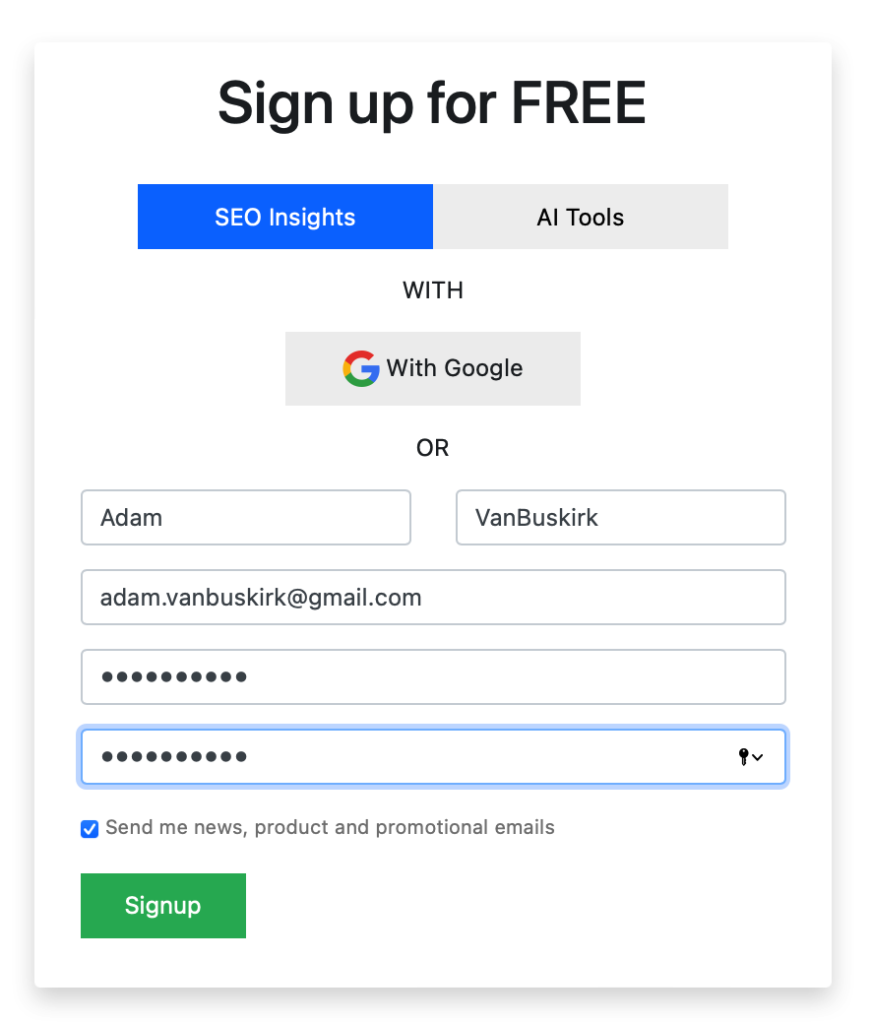
Login and Create an SEO Insights project
To use the various SEO Insights Tools, including the keyword stuffing checker tool, you have to first create what we call and SEO Insights Project. A project is just a container for holding your various webpages that you want to run analysis on and use tools against. You can see below several projects I’ve created.

Enter The Keyword Phrase & Your Webpage URL
Once inside a project, you can enter the keyword(s) you want to target and optionally the URL of your webpage. If you don’t have a webpage yet and are just checking the keyword usage of competitor webpages, you can leave the URL empty and add it later. As you add webpages, you’ll see them stack up within the project. See below a list of some of my articles for this blog.

Run a Competitor Analysis, Which Will Pull The Keyword Densities
After adding a webpage, click the run button to crawl your webpage and the top 10 webpages as ranked in Google for the keyword. After crawling the webpages, wordbot will extract critical on-page SEO stats and all the relevant keywords across the webpages. It will then take this data and build useful heat maps for checking on-page stats and keyword usage.

Navigate to the Keywords Tab
After wordbot is done extracting data and building the heat maps, click the graph button and navigate to the Keywords tab. In this tab you will see all relevant keywords for you and your competitors’ webpages. You will also see their usage in terms of times used. Each keyword for each webpage will be colored deep green to deep red based on their comparative usage to the top ranked webpage in Google. This allows you to quickly judge how well you rank against the best content.
Check The Density Toggle
At this point, you’re ready to use the keyword stuffing checker tool. Toggle the Show Density switch to on in the top right of the tool. You will see all the keyword counts in the grid change to percentages. These are the densities of each keyword. It now becomes very easy to see those webpages that are keyword stuffing, those that have healthy densities, and those that aren’t using the keyword near enough.
We mentioned in the very beginning of this article that .5 – 2% is commonly referred to as healthy densities, but are they really? First, .5 – 2 is a large range depending on the word count, so we’re already conflicted. For example, for a 1,000 word article do I use the keyword 5 times or 20 times?
We believe rather than guessing at a correct density, you should use a correct density based on fact. Using this tool, you can see exactly what densities the top ranking webpages use and do the same. You then know you are using the best possible keyword densities and not keyword stuffing or using too few. Below is a screenshot of the density heat map.
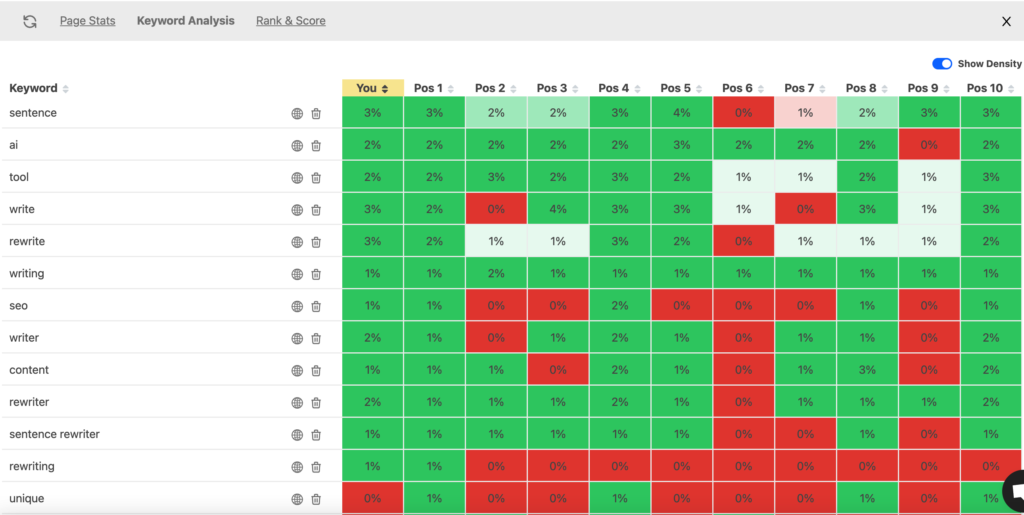
Keyword Stuffing Checker Examples
We’ll end this blog post with showing you some screenshots from the tool. We’re not going to break these examples down. We show them as is so you can get a general idea of the density grids. The below screenshots are from the density checker and represent actual analysis I’ve ran while writing various articles for this blog. Study them and see if you can find examples of good keyword usage, low keyword usage, and high (stuffed) keyword usage.
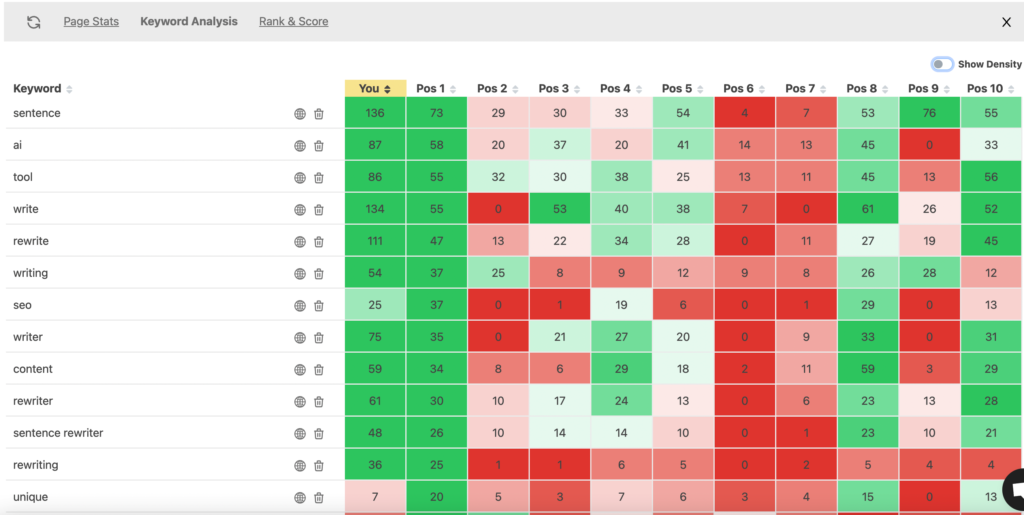
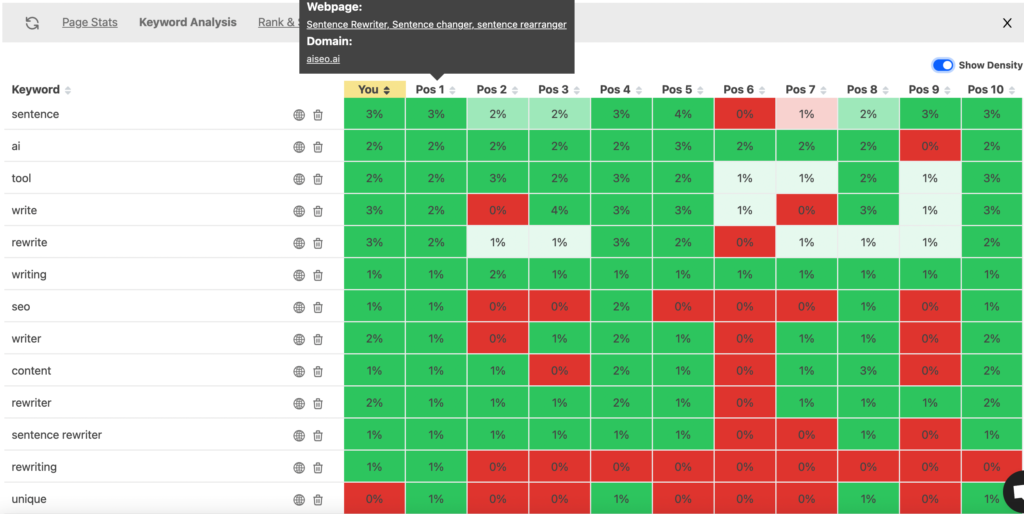
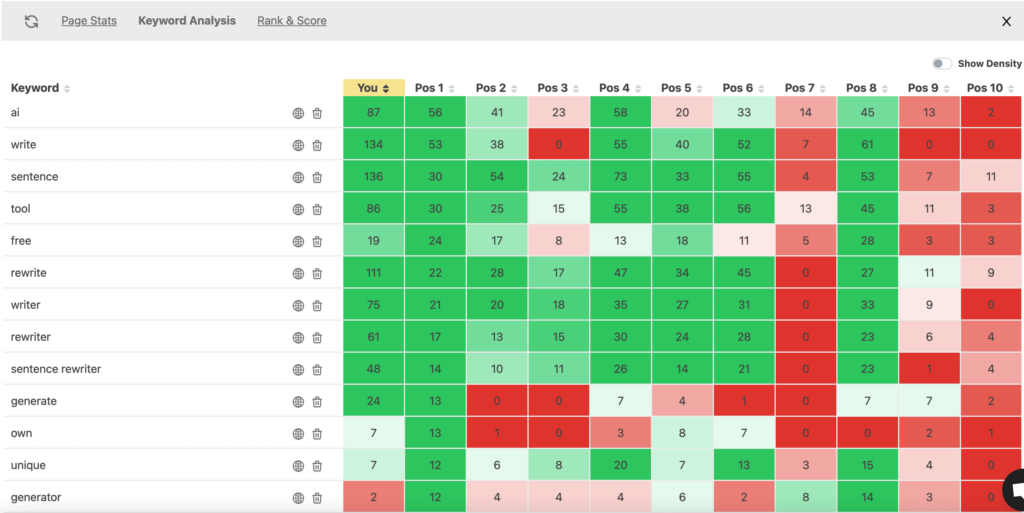
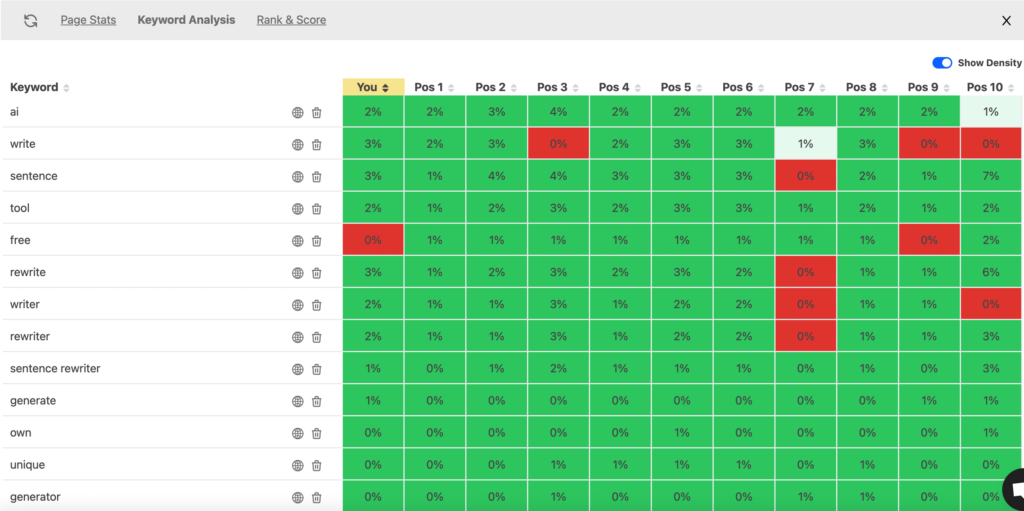
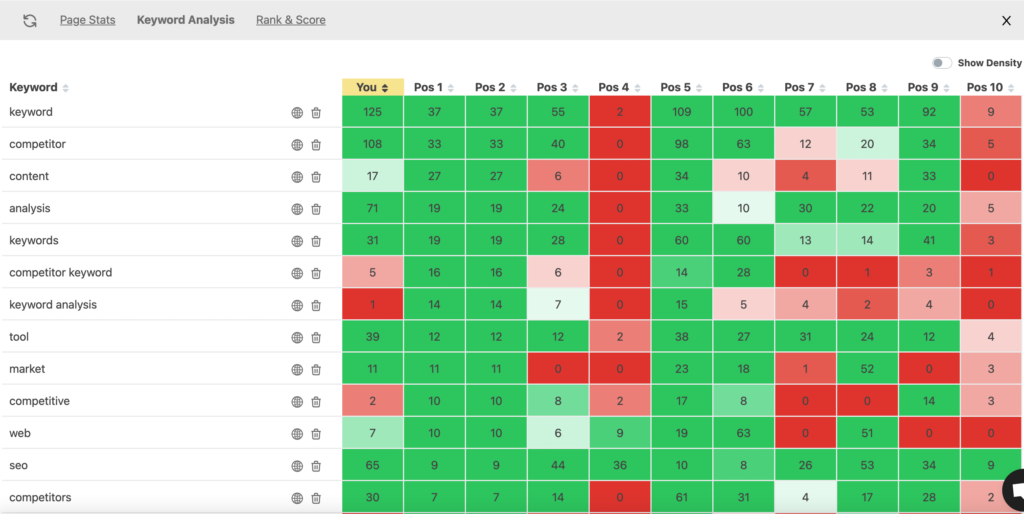

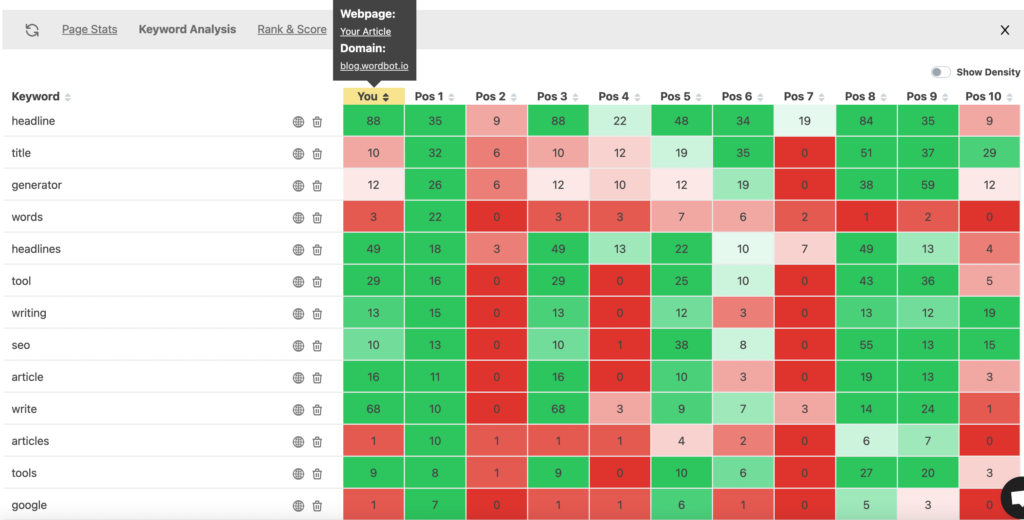

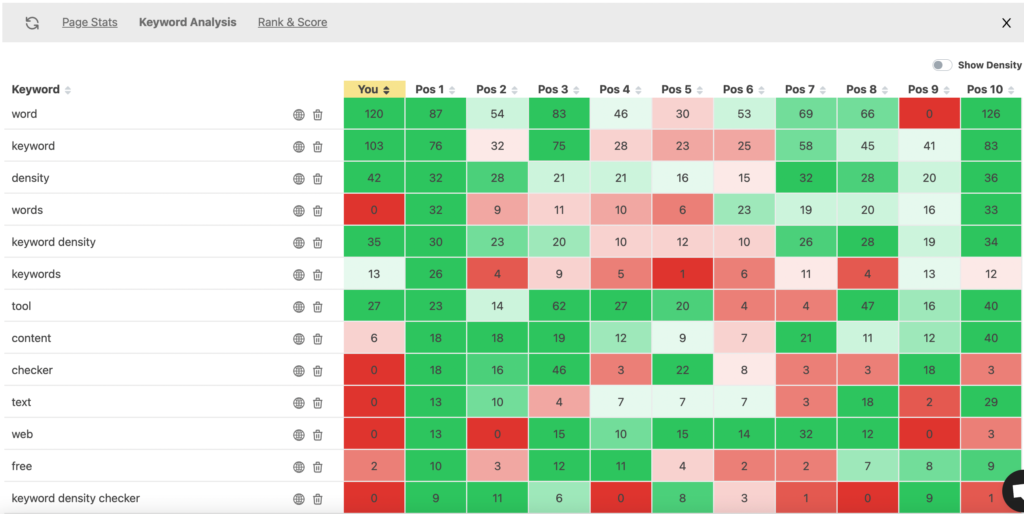

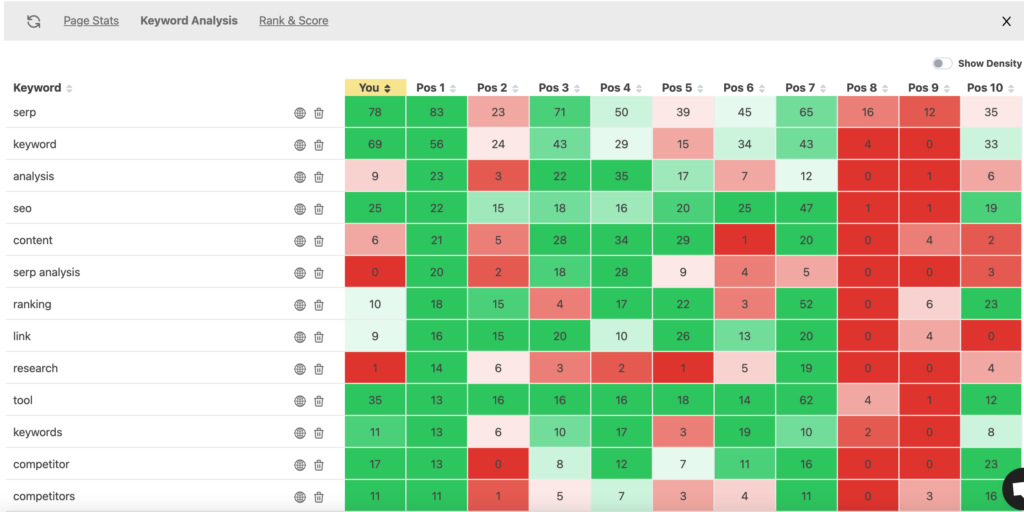
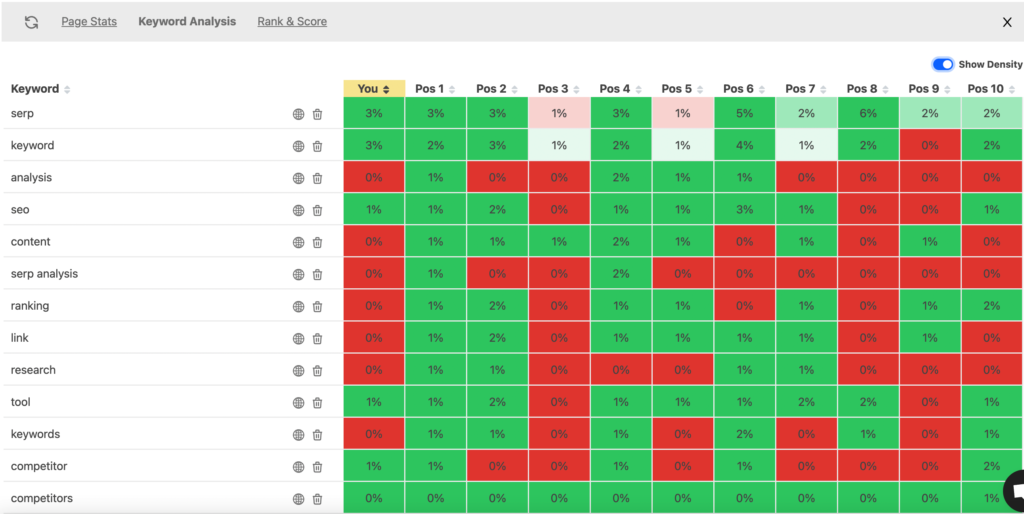
H2 Conclusion
After writing any content with a substantial word count, it’s always a good idea to use a keyword stuffing checker tool to review your keyword usage and ensure you didn’t accidentally stuff keywords. Using a density checker also highlights if you under-utilized your targeted keywords. It does this by displaying your keyword densities beside the densities of your top ranked competitors and the best curated content.
Give our free keyword stuffing checker a try and see how easy it is to nail your keyword usage. Our product is in its infancy, so we’re always adding features and making enhancements.







